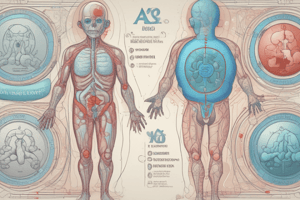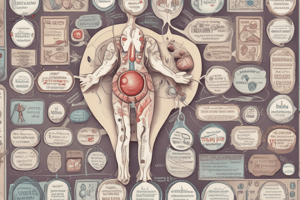Podcast
Questions and Answers
A 55-year-old obese patient presents with gradually increasing hyperglycemia but no history of ketoacidosis. Initial tests show insulin resistance. Which of the following is the MOST likely diagnosis?
A 55-year-old obese patient presents with gradually increasing hyperglycemia but no history of ketoacidosis. Initial tests show insulin resistance. Which of the following is the MOST likely diagnosis?
- Latent autoimmune diabetes in adults (LADA)
- Type 1 diabetes mellitus
- Type 2 diabetes mellitus (correct)
- Gestational diabetes
Which statement BEST describes the underlying pathophysiology that differentiates type 1 from type 2 diabetes?
Which statement BEST describes the underlying pathophysiology that differentiates type 1 from type 2 diabetes?
- Type 2 diabetes typically presents with abrupt onset of hyperglycemia, unlike type 1 diabetes.
- Only type 1 diabetes is associated with the presence of auto-antibodies.
- Type 1 diabetes involves insulin resistance, whereas type 2 diabetes involves absolute insulin deficiency.
- Type 1 diabetes is characterized by absolute insulin deficiency, while type 2 diabetes involves insulin resistance with relative insulin deficiency. (correct)
A patient newly diagnosed with type 1 diabetes is started on insulin therapy. Which of the following clinical presentations would MOST strongly suggest that the insulin therapy is effectively addressing the underlying pathophysiology of their condition?
A patient newly diagnosed with type 1 diabetes is started on insulin therapy. Which of the following clinical presentations would MOST strongly suggest that the insulin therapy is effectively addressing the underlying pathophysiology of their condition?
- Absence of autoantibodies in subsequent blood tests.
- Normalization of blood pressure and improved lipid profile.
- Prevention of diabetic ketoacidosis (DKA) and maintenance of euglycemia. (correct)
- Reduced requirement for exogenous insulin over time.
A researcher is evaluating the efficacy of a novel drug designed to improve glycemic control in patients with type 2 diabetes. Which outcome would provide the STRONGEST evidence of the drug's clinical efficacy?
A researcher is evaluating the efficacy of a novel drug designed to improve glycemic control in patients with type 2 diabetes. Which outcome would provide the STRONGEST evidence of the drug's clinical efficacy?
A patient with type 2 diabetes is prescribed an oral antidiabetic medication. What primary mechanism of action would be MOST beneficial in addressing the underlying pathophysiology of their condition?
A patient with type 2 diabetes is prescribed an oral antidiabetic medication. What primary mechanism of action would be MOST beneficial in addressing the underlying pathophysiology of their condition?
A researcher is investigating novel approaches to enhance insulin receptor signaling in peripheral tissues resistant to insulin. Which of the following strategies, targeting intracellular signaling cascades, would MOST directly amplify the effects of insulin binding at the cellular level, bypassing proximal receptor defects?
A researcher is investigating novel approaches to enhance insulin receptor signaling in peripheral tissues resistant to insulin. Which of the following strategies, targeting intracellular signaling cascades, would MOST directly amplify the effects of insulin binding at the cellular level, bypassing proximal receptor defects?
A clinical trial is designed to compare the efficacy of various insulin delivery methods on glycemic variability. Which metric would provide the MOST comprehensive assessment of glycemic fluctuations, capturing both the magnitude and frequency of glucose excursions throughout the day?
A clinical trial is designed to compare the efficacy of various insulin delivery methods on glycemic variability. Which metric would provide the MOST comprehensive assessment of glycemic fluctuations, capturing both the magnitude and frequency of glucose excursions throughout the day?
Consider an experimental therapy involving targeted gene editing to correct a mutation causing complete insulin deficiency. Which of the following approaches would offer the MOST durable and physiologically responsive restoration of endogenous insulin production?
Consider an experimental therapy involving targeted gene editing to correct a mutation causing complete insulin deficiency. Which of the following approaches would offer the MOST durable and physiologically responsive restoration of endogenous insulin production?
A patient with longstanding type 2 diabetes develops worsening renal function. Which of the following antidiabetic medications requires the MOST careful dose adjustment and monitoring due to its potential for exacerbating renal impairment or causing drug accumulation leading to increased risk of adverse effects?
A patient with longstanding type 2 diabetes develops worsening renal function. Which of the following antidiabetic medications requires the MOST careful dose adjustment and monitoring due to its potential for exacerbating renal impairment or causing drug accumulation leading to increased risk of adverse effects?
In the context of developing a novel therapeutic strategy for type 2 diabetes, which of the following approaches would MOST directly address both insulin resistance in peripheral tissues and beta-cell dysfunction, thereby targeting the core pathophysiological defects of the disease?
In the context of developing a novel therapeutic strategy for type 2 diabetes, which of the following approaches would MOST directly address both insulin resistance in peripheral tissues and beta-cell dysfunction, thereby targeting the core pathophysiological defects of the disease?
Flashcards
Insulin's Action
Insulin's Action
Hormone that lowers blood glucose by allowing cells to uptake glucose and promoting glycogen storage.
Diabetes Types
Diabetes Types
Type 2 involves insulin resistance and relative deficiency; Type 1 involves absolute insulin deficiency.
Type 2 Diabetes Cause
Type 2 Diabetes Cause
Insulin resistance combined with a relative deficiency in insulin production.
Type 1 Diabetes Cause
Type 1 Diabetes Cause
Signup and view all the flashcards
Type 2 Characteristics
Type 2 Characteristics
Signup and view all the flashcards
Type 2 Diabetes
Type 2 Diabetes
Signup and view all the flashcards
Type 1 Diabetes
Type 1 Diabetes
Signup and view all the flashcards
Type 2 Onset/Treatment
Type 2 Onset/Treatment
Signup and view all the flashcards
Type 1 Onset/Treatment
Type 1 Onset/Treatment
Signup and view all the flashcards
Type 1 Autoimmunity
Type 1 Autoimmunity
Signup and view all the flashcards
Study Notes
- The lecture provides an overview of the pharmacology of Diabetes Mellitus
- The lecturer is Prof Steve Safrany 341
- These notes are for the Year 2 Endocrine and Breast module, January 2024
Learning Outcomes
- Describe the mechanism of action of insulin, and know its therapeutic and adverse effects
- Compare and contrast different types of insulin preparations & regimens used to treat diabetes, and know their advantages and disadvantages
- Discuss potential future directions for insulin therapy in diabetes mellitus, including new insulin formulations, devices, & technologies
- Recognise principles of pharmacotherapy of type 2 diabetes, including different classes of drugs, their mechanism of action, and adverse effects
- Evaluate the clinical efficacy of antidiabetic drugs, including their effects on glycemic control, weight, blood pressure, lipid profiles, and other outcomes
Diagnosis of Diabetes
- Diagnosis involves measuring plasma glucose levels
- Fasting plasma glucose of ≥7.0 mmol/L (126 mg/dL) indicates diabetes
- An HbA1c ≥48 mmol/mol (6.5%) indicates diabetes
- A two-hour plasma glucose ≥11.1 mmol/L (200 mg/dL) after a 75g oral glucose load (oral glucose tolerance test (OGTT)) indicates diabetes
- Random plasma glucose ≥11.1 mmol/L (200 mg/dL) in the presence of hyperglycaemia symptoms also indicates diabetes
Type 2 vs Type 1 Diabetes
Type 2 Diabetes
- There is insulin resistance with relative insulin deficiency
- Hyperglycemia develops gradually with progressive decline in beta-cell function, initially silent
- Patients can be treated with oral medications
- Onset is associated with increasing age and obesity
Type 1 Diabetes
- There is absolute insulin deficiency
- There is abrupt onset of hyperglycemia and propensity for development of DKA
- Insulin is required
- Auto antibodies are associated with Type 1
- Predominant type of diabetes is diagnosed in individuals <30 years old
Management of DM
Type 2 Diabetes
- A multidisciplinary approach that includes:
- Patient education & support is required
- Lifestyle modifications (diet, physical activity, & weight loss) is required
- Pharmacologic therapies (oral, GLP-1 agonists, insulin) are often needed
- Bariatric surgery can be considered
Type 1 Diabetes
- A multidisciplinary approach that includes
- Patient education & support
- Dietary advice (carb counting, glycaemic index diets, dietary advice) and physical activity advice
- Insulin therapy (injections or insulin pump)
- Newer treatments on the horizon (islet cell, stem cell)
Indications for Insulin
- Type 1 diabetes
- Inadequately controlled type 2 diabetes
- Temporary use in:
- Hospitalisation/surgery
- Pregnancy
- Renal disease (when there are limited options for oral medications)
- Initiating glycemic control in patients with severe new onset type 2 diabetes
Treatment of Type 1 Diabetes
- It involves insulin replacement therapy
- Adjust doses according to:
- Carbohydrate intake
- Exercise regimen
- Blood glucose profile
- Perform blood glucose tests and adjust insulin appropriately
- Monitor for complications
Bolus Insulin
- It is a rapid or short-acting insulin given before meals
- It provides coverage for food intake or correction of hyperglycemia
Short Acting Bolus Insulin
- Regular insulin
Rapid Acting Bolus Insulin
- Aspart
- Lispro
- Glulisine
- (Insulin human) inhalation powder
Basal Insulin
- It aims to mimic physiologic insulin secretion
- It maintains euglycemia in the fasting state
Intermediate Acting Basal Insulin
- NPH (Neutral Protamine Hagedorn), given once or twice daily
Long Acting Basal Insulin
- Glargine - once daily
- Detemir - once or twice daily
- Degludec - once daily
NPH – intermediate acting
- Neutral protamine Hagedorn
- Includes Humulin N, Novolin N, Novolin NPH, and isophane insulin
- Created in 1936 as first basal insulin
- A suspension of crystalline zinc insulin combined with the positively charged polypeptide, protamine*
- Has an intermediate duration of action (10-20 hours)
- It can be combined with other insulins
- A peak in action increases risk of hypoglycemia
Insulin Glargine – Basal Insulin
- It creates a peakless 24-hour insulin
- Insulin molecule modifications include:
- Substitution of glycine at A21
- Addition of two arginines at B30
- It has a unique release pattern at injection site
Pharmacodynamics of Insulin
- Aspart/lispro/glulisine has an onset of action of 5-15 min, peak in 1-2 hrs, and lasts for 4-6 hrs
- Regular insulin has an onset of action of 30-60 min, peaks in 2-4 hrs, and lasts for 6-10 hrs
- Human NPH has an onset of action of 1-2 hrs, peaks in 4-8 hrs, and lasts for 10-20 hrs
- Glargine has an onset of action of 1-2 hr, lasts ~24 hrs
- Detemir has an onset of action of 0.8-2 hr, lasts up to 24 hrs
- Degludec has an onset of action of 1 hr, lasting up to 42 hrs
Insulin Administration Regimens
Conventional
- Basal insulin only
- Twice daily mixed split
- Intermediate (N) + Short (Regular or Rapid acting)
- Includes 70/30 or 75/25 insulin
- 70-75% N
- 25-30% R or Rapid acting
Basal-Bolus
- Long-acting insulin + Rapid-acting insulin is taken with each meal
Insulin Pump
- Continuous subcutaneous insulin infusion can be administered via an insulin pump
Pitfalls of Conventional Twice-Daily Split-Mixed Regimen
- It results in endogenous insulin
- The timing of Dawn phenomenon, breakfast, dinner, and other timings are critical
Mimicking Nature: The Basal-Bolus Insulin Concept
- It is designed to mimic endogenous insulin to create a system that closely resembles natural insulin level fluctuation
Insulin Pump Therapy
- An insulin pump administers insulin through a catheter in the abdominal fat to help control a person's blood sugar levels
Pharmacokinetic Advantages of the Insulin Pump (CSII)
- It uses rapid-acting insulin
- It uses 1 injection site
- Basal insulin requirements supplied in mini-boluses every 5 minutes (Closed loop technology)
Automated Insulin Delivery Systems (Hybrid Closed Loop Device)
- It comprises an insulin pump and a continuous glucose monitor (CGM) with integrated functioning
- It enables automatic adjustment of insulin delivery
- An algorithm adjusts basal rates based on glucose
- A patient still needs to administer pre-meal insulin boluses
- Benefits include increased time spent in target glucose range and reduced incidences of severe hypoglycemia
- It has high costs
Inhaled Insulin
- Rapid-acting insulin adsorbed onto carrier particles
- It is delivered via inhalation
- The median time for maximum effect is 53 minutes
- The duration of action is 160 minutes
- Approved to cover prandial insulin requirements in non-smoking adults with DM with free of pulmonary disease
- It is rarely used – less effective than subcutaneous insulin and may be toxic for the pulmonary system
Insulin Side Effects
- It is a safe treatment when used appropriately
- Hypoglycemia is the most common complication
- Insulin Lipodystrophies can occur
- Lipoatrophy: Localised loss of subcutaneous fat at injection sites
- Lipohypertrophy: Swelling of subcutaneous fat at injection sites
- Allergies can occur
- Local: itching, burning, erythema, hive formation
- Systemic: urticaria/bronchospasm
Summary of Insulin Use
- Insulin is used in the treatment of both type 1 and type 2 diabetes
- Multiple daily injections (basal-bolus) are most commonly used
- Hypoglycemia is a common side effect of insulin therapy, so patient education is important
- A basal-bolus regimen via subcutaneous injections or continuous insulin infusion most closely simulate normal insulin physiology
Principles of Glucose Lowering Agents in Type 2 Diabetes
- Multiple drugs are available, each with tissue-specific action
- All are contraindicated in pregnancy except glyburide (sulfonylurea) and metformin
- Can be used in any combination except sulfonylureas should not be used with meglitinides
- Metformin is generally the first drug of choice
- One can start with multiple classes of drugs
Insulin Resistance
- Clinical conditions associated include:
- Hypertension (Prehypertension)
- Type 2 Diabetes
- Impaired Glucose Tolerance
- Atherosclerosis (Endothelial Dysfunction)
- Obesity (Central Visceral)
- Dyslipidemia
- ↓HDL
- ↑ LDL
- ↑TG
- Polycystic Ovary Disease
- Decreased Fibrinolytic Activity
- Acanthosis Nigricans
Pathogenesis of Hyperglycaemia in T2D
- Insulin resistance: defects in insulin signaling prevent uptake by liver and peripheral tissues
- Increased glucose production
- Insufficient glucose disposal
Organs Regulating Plasma Glucose
- Pancreas
- Liver
- Muscles
- Gut
- Brain
- Kidneys
Metformin (Glucophage)
- Action:
- Acts on the liver (activates AMPK?)
- Reduces hepatic glucose output (i.e., reduces gluconeogenesis)
- Decreases glucose absorption in large intestine
- Increases insulin-mediated glucose utilisation in peripheral tissues
- Is associated with mild weight loss
- Does not cause hypoglycaemia
- Efficacy: can lower HbA1c as much as 2%
- Most commonly prescribed drug for T2D
Side Effects and Contraindications of Metformin
- Side effects*
- GI upset – anorexia, nausea, and diarrhoea (most common)
- Lactic Acidosis – rare, but a concern due to high-case fatality rate
- Vitamin B12 deficiency – due to reduction in intestinal absorption of B12 – rarely causes megaloblastic anaemia
- Contraindications
- Patients prone to metabolic acidosis
- T1D
- Renal failure
- eGFR 30-45ml/min – lower dose
- eGFR <30ml/min – avoid
Insulin Secretagogues: 1. Sulfonylureas
- Names include Glipizide, glimepiride, glyburide
- Action involves stimulating pancreatic insulin secretion for 12-24 hours
- Mechanism includes binding K+ channels/sulfonylurea receptors (SUR) in ẞ cells, resulting in K+ accumulation and depolarisation, causing Ca2+ entry and insulin release
- It has an immediate effect mostly on pre-meal glucose
- Hepatically metabolised, excreted via kidney with active metabolites so caution in renal impairment is required
- Contraindications include T1DM, DKA, sulfa allergy
- Adverse effects include hypoglycemia, weight gain, hunger
- Efficacy: Lowers A1c up to 1.5%
Meglitinides/glinides
- Name: repaglinide
- It stimulates insulin secretion for 3-4 hours
- Mechanism is same as sulfonylureas
- Results in a fast onset
- Side effects cause lower glucose 2-4 hours after meal, and weight gain
- Disadvantage involves reduced patient compliance
- Contraindications include T1DM, liver failure, DKA, sulfa allergy
- Metabolism: hepatic by CYP 450 enzymes system, 96% metabolites excreted via GI tract
- Efficacy: Lowers A1c ~ 1.4%
Alpha-glucosidase Inhibitors
- Name: acarbose
- Mechanism: competitive inhibition of enzymes in the small intestinal brush border to break down oligosaccharides and disaccharides into monosaccharides
- Action: delays gut carbohydrate absorption, increasing GLP-1
- Effects: only affects post-prandial glucose
- Administration: requires a pill taken with meals
- Side effects: flatulence, abdominal bloating
- Contraindications: GI disorders, esp. IBD
- Metabolism: renally excreted as unchanged drug
- Does not induce hypoglycemia
- Efficacy: lowers A1c ~ 0.4%
Incretin Hormones
- Released from gut after eating and enhance insulin secretion
- GLP-1 and GIP are the main incretin hormones responsible for this effect in healthy individuals
- In T2DM, the incretin effect is often impaired
- This impairment may contribute to poor glucose regulation and reduced insulin secretion from the pancreas in T2DM
- ↑ Glucose uptake by adipose and muscle tissue
- Blood glucose homeostasis
GLP-1
- Leads to increased insulin production and lowered Glucagon productio
- Slows Gut motility
- Induces Satiety
GLP-1 Receptor Agonists (GLP-1 RA)
- Names : Semaglutide, liraglutide, dulaglutide
- Mechanism: Enhancement of glucose-dependent insulin secretion, slowed gastric emptying, & reduction of postprandial glucagon & food intake
- Action is potent glucose-dependent insulin secretion, inhibits glucagon secretion, indirectly slows gastric emptying, stimulates satiety
- Administration: subcutaneous injection (daily or weekly), semaglutide also available oral
- Side effects: GI (nausea, vomiting, diarrhea), pancreatitis (<1% risk)
- Contraindications: Pancreatitis
- Does not induce hypoglycaemia
- Efficacy: lowers A1c 0.5-1.4%, weight loss
- There is a reduction in ASCVD outcomes and CV mortality in patients with T2D & CVD taking GLP-1 RA (liraglutide, semaglutide, dulaglutide)
GIP/GLP-1 Receptor Agonist
- Name: Tirzepatide
- Mechanism: synthetic dual-acting agonist, targeting GIP & GLP-1 receptors
- Action: GIP enhances effects of GLP-1, potent glucose-dependent insulin secretion, inhibits glucagon secretion, indirectly slows gastric emptying, stimulates satiety
- Administration: subcutaneous injection weekly
- Side effects: GI (nausea, vomiting, diarrhea), pancreatitis (<1% risk)
- Contraindications: Pancreatitis
- Does not induce hypoglycaemia
- Efficacy: Lowers A1c 2%, weight Loss
DPP IV Inhibitors
- Names: Sitagliptin, linagliptin, vildagliptin, saxagliptin
- Action: increases duration of action of GLP-1 and GIP
- The mechanism inhibits dipeptidyl peptidase-4 with 80% inhibition at 24 hours
DPP IV Inhibitors Metabolism
- Sitagliptin and saxagliptin are not metabolized; excreted unchanged through the kidneys, dose adjusted for renal insufficiency
- Linagliptin is hepatically metabolised
- They are administered once daily by mouth
- Contraindications: pancreatitis
- Adverse effects: gastrointestinal
- Do not induce hypoglycemia and are weight neutral
- Efficacy: lowers A1c ~0.7%
Normal Renal Glucose Handling
- The kidneys filter and reabsorb 180 g of glucose per day
- SGLTs are responsible for this reabsorption
- Majority of glucose (90%) is reabsorbed by SGLT2
- Remaining glucose is reabsorbed by SGLT1 (10%)
- Results in minimal to no glucose excretion
SGLT2 Inhibitors
- Lower blood glucose levels by acting on the kidney by increased urinary excretion of excess glucose (~70 g/day, corresponding to 280 kcal/day*)
- Name: Empagliflozin, canagliflozin, dapagliflozin
- Mechanism: Excretion of 50-100 grams glucose/day
- Metabolism: Mainly hepatic with some metabolites excreted via kidney
- Contraindications: Severe renal impairment, ESRD, or on dialysis
- Side effects: Vulvovaginal candidiasis, vulvovaginal mycotic infection, urinary tract infections, and polyuria, small risk of euglycemic DKA
- Efficacy: lowers A1c by as much as 0.7% (canagliflozin 0.9-1%)
- Weight loss of ~ 2.2%
-
- Cardiovascular risk benefit. Also approved for heart failure and CKD
Summary of Diabetes Drugs Effects
- Biguanide (metformin): Decreases weight, used with caution GFR <30
- Sulfonylureas (glipizide): Increases weight, with caution reduced renal clearance in kidney failure
- Alpha-glucosidase inhibitors (acarbose): is weight neutral, with caution in kidney disease
- Thiazolideniones (pioglitazone): Increases Weight, use caution CV events/mortality (rosiglitazone)
- DPP IV inhibitor (sitagliptin): is weight neutral, with caution to pancreatitis
- GLP-1 agonist (semaglutide): Decreases Weight, use caution to Pancreatitis, HF (saxagliptin)
- SGLT-2 inhibitor (dapagliflozin): Decreases Weight, use caution with PAD
Studying That Suits You
Use AI to generate personalized quizzes and flashcards to suit your learning preferences.
Related Documents
Description
This quiz covers the diagnosis, pathophysiology, and treatment approaches for diabetes mellitus, focusing on differentiating between type 1 and type 2 diabetes. It explores insulin resistance, clinical presentations, and the efficacy of antidiabetic drugs in managing glycemic control. The content addresses key aspects of diabetes management and underlying mechanisms.





